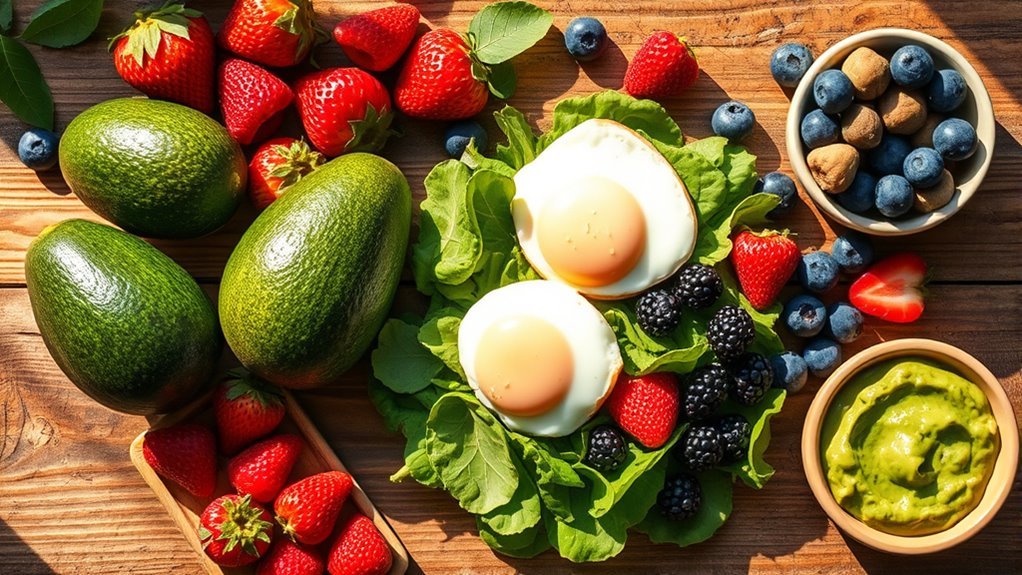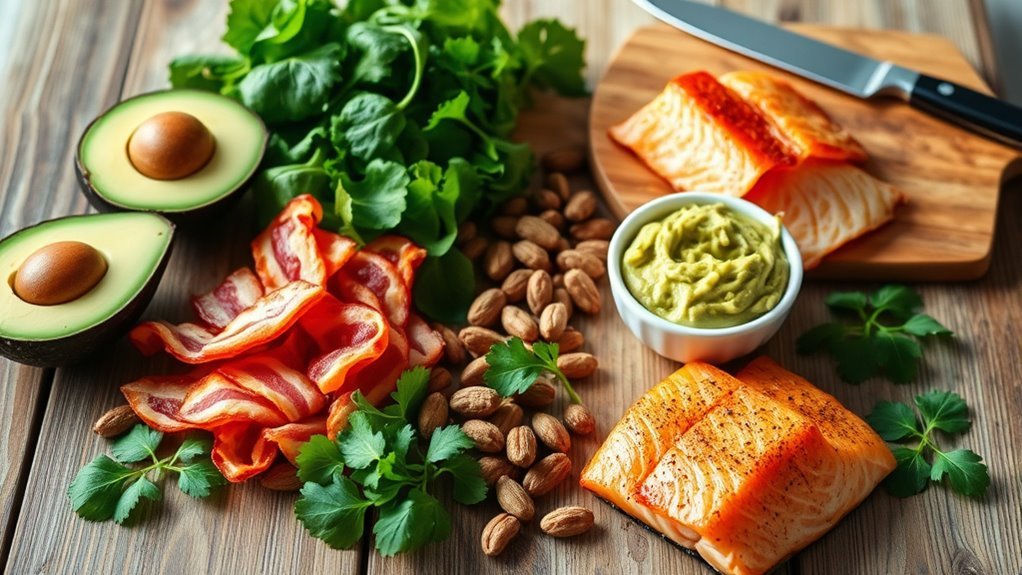The keto diet is a high-fat, low-carbohydrate eating plan that shifts your body into ketosis, where fat becomes your primary energy source instead of carbs. By drastically reducing carb intake, your body produces ketones from fatty acids, enhancing energy levels and mental clarity. You’ll focus on healthy fats and protein while avoiding sugars and grains. If you’re curious about how this diet works and its benefits, there’s more valuable information to explore.
Understanding the Basics of Keto

When you begin the keto diet, it’s essential to understand its foundational principles. This high-fat, low-carbohydrate approach shifts your body into ketosis, where it burns fat for energy instead of glucose. However, many keto misconceptions can cloud your understanding. For instance, some believe you can eat unlimited fat without consequence. In reality, portion control and nutrient balance are key. Additionally, keto myths often suggest that the diet is unsustainable or unhealthy in the long run. Research shows that, when done correctly, keto can promote weight loss and improve metabolic health. Educating yourself about these fundamentals can empower you to make informed choices, allowing you to embrace the freedom this lifestyle offers while avoiding common pitfalls.
How the Keto Diet Works

The keto diet works by drastically reducing carbohydrate intake, which forces your body to enter a metabolic state known as ketosis. In this state, your body shifts from using glucose as its primary energy source to burning fat. This change enhances keto metabolism, leading to increased fat breakdown and ketone production. Ketones are molecules your liver creates from fatty acids, serving as an alternative fuel that your brain and body can efficiently utilize. As you stick to a low-carb lifestyle, your body’s reliance on these ketones can lead to improved energy levels, mental clarity, and appetite suppression. Embracing this diet allows you to experience the freedom of harnessing fat for energy, promoting overall health and wellness.
Types of Keto Diets

When exploring the types of keto diets, you’ll find several variations designed to meet different lifestyle needs. The Standard Keto Diet is the most common, while the Targeted Keto Diet allows for more flexibility around physical activity. Understanding these options can help you choose a plan that aligns with your health goals.
Standard Keto Diet
While many variations of the keto diet exist, the Standard Keto Diet (SKD) remains the most widely practiced and researched. This approach typically consists of high-fat, moderate-protein, and low-carb intake, allowing your body to enter a state of ketosis. For effective keto meal planning, understanding the macronutrient ratios is essential. Here’s a breakdown:
| Macronutrient | Percentage | Foods to Include |
|---|---|---|
| Fat | 70% | Avocados, oils, nuts |
| Protein | 25% | Meat, fish, eggs |
| Carbohydrates | 5% | Leafy greens, berries |
With a variety of keto recipes available, you can enjoy diverse meals while adhering to these guidelines. Embracing SKD provides freedom in food choices, helping you achieve your health goals.
Targeted Keto Diet
How can you optimize your workouts while still reaping the benefits of a ketogenic diet? The Targeted Keto Diet (TKD) offers a solution through a targeted approach, allowing you to consume extra carbohydrates around your workout times. This method helps fuel high-intensity exercise without disrupting ketosis.
When implementing a TKD, consider the timing and quantity of carbs—typically 20-50 grams before workouts. This strategy supports energy levels during intense sessions while maintaining fat-burning benefits during the rest of the day.
Foods to Eat on a Keto Diet
When following a keto diet, focusing on low-carb vegetables and healthy fat sources is essential for maintaining ketosis. These foods not only provide essential nutrients but also help in managing hunger and energy levels. Incorporating spinach, avocados, and olive oil can greatly enhance your keto meal plan.
Low-Carb Vegetables
Incorporating low-carb vegetables into your keto diet is essential for maintaining nutritional balance while keeping your carbohydrate intake in check. These keto-friendly options, like spinach, zucchini, and bell peppers, offer high nutrient density without spiking your carb levels. They provide vitamins, minerals, and fiber, which support overall health and digestion. By choosing these vegetables, you can enhance your meals while enjoying the freedom of a varied diet. Aim to fill your plate with colorful, low-carb choices to guarantee you’re getting a range of nutrients. Remember, not all vegetables are created equal on a keto diet, so focus on those that align with your goals. This way, you can thrive on your keto journey without feeling deprived.
Healthy Fats Sources
Healthy fats are a cornerstone of the keto diet, providing essential energy and supporting various bodily functions. Incorporating sources like avocados and coconut oil can enhance your health while keeping you in ketosis. Avocado benefits include high levels of monounsaturated fats, which may improve heart health and lower cholesterol levels. Plus, they’re rich in fiber, promoting digestive health. Coconut oil, on the other hand, contains medium-chain triglycerides (MCTs) that your body can quickly convert into energy, making it an ideal fat source for your keto journey. By focusing on these healthy fats, you’re not only nourishing your body but also enjoying a diverse and satisfying diet that aligns with your health goals. Embrace these options for a fulfilling keto experience!
Foods to Avoid on a Keto Diet
To successfully navigate a ketogenic diet, it’s crucial to know which foods to avoid, as consuming the wrong items can hinder your progress towards ketosis. First, steer clear of high-carb foods like grains, bread, and pasta, as they can spike your insulin levels. Sugary snacks and desserts are also off-limits—check labels for hidden sugars and avoid those sugar substitutes that can still impact your blood sugar. Fruits tend to be high in carbohydrates, so limit your intake, focusing on lower-carb options like berries in moderation. While you might crave keto snacks, make sure they’re low in carbs and free of fillers. By avoiding these foods, you’ll create a solid foundation for your keto journey and maintain your freedom to choose wisely.
Potential Benefits of the Keto Diet
One of the most notable benefits of the keto diet is its potential for significant weight loss. By shifting your body into a state of ketosis, you can efficiently burn fat for fuel, which may lead to impressive results. Beyond weight loss, the keto diet offers several other advantages:
- Enhanced mental clarity
- Reduced cravings and appetite
- Improved energy levels
- Better blood sugar control
- Potential therapeutic effects for certain neurological disorders
These benefits come from the diet’s ability to stabilize insulin levels and promote fat oxidation. As you embrace this lifestyle, you might find not only a slimmer waistline but also a sharper mind and a renewed sense of freedom in your daily activities.
Possible Side Effects and Considerations
While the keto diet offers numerous benefits, it’s important to be aware of the potential side effects and considerations that may arise as you adopt this low-carbohydrate, high-fat lifestyle. You might experience the “keto flu,” a temporary phase with symptoms like fatigue and headaches. Electrolyte imbalances can occur, leading to cramps or dizziness, so hydration is essential. Additionally, digestive issues and nutrient deficiencies may arise due to limited food variety. Long-term sustainability can be challenging, and some may face weight regain after returning to previous eating habits. It’s also important to monitor your cholesterol levels, as they can fluctuate. Finally, individuals with a predisposition to kidney stones should consult a healthcare provider before starting this diet.
Tips for Starting a Keto Diet
Wondering how to successfully start a keto diet? Here are some practical tips to help you navigate smoothly and enjoy your new lifestyle:
- Plan your meals: Effective meal prep can save time and keep you aligned with your carb goals.
- Explore snack ideas: Stock up on keto-friendly snacks like nuts, cheese, or veggie sticks to curb cravings.
- Stay hydrated: Drink plenty of water to help manage any initial side effects and support overall health.
- Monitor your macros: Keep track of your carbohydrate, fat, and protein intake to verify you’re on the right path.
- Be patient: Adjusting to a keto diet may take time, so allow your body to adapt and listen to its needs.
Embrace the freedom of a healthier lifestyle!


